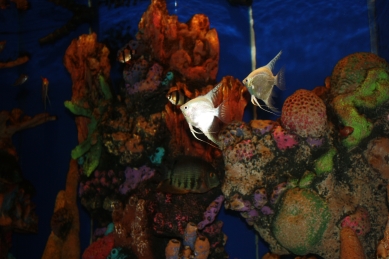About The Rhythm House and reviews
BEAT THE HEAT IN OUR NICE COOL "AIR CONDITIONED" BUILDING!
For Reservations:
CALL 863-336-1876
"The Rhythm House" is a Restaurant and Nightclub located in Fort Myers, FL. At The Rhythm House we strive to provide Great Service, Top Quality Food and Drinks as well as Live Entertainment Five Nights A Week. Featuring Excellent Food as well as Well-known Local Talent! We offer live music every Tuesday through Sunday. We have the best HARD WOOD DANCE FLOOR and Sound Systems in the area! Come and relax. Listen to GREAT MUSIC, enjoy an EXCELLENT DINNER and a couple of DRINKS with your friends, neighbors or colleagues and experience the love of music for yourself.
All Bands Start at 6:30 and conclude at 9:30
SATURDAY NIGHTS .00 COVER CHARGE
Reservations Suggested but not required for all shows!
THE RHYTHM HOUSE IS NOW OPEN TILL 2AM
EVERY THURSDAY, FRIDAY AND SATURDAY!
* CLICK HERE TO VIEW OUR UPCOMING SPECIAL EVENTS & ENTERTAINMENT CALENDAR *
* CLICK HERE FOR OUR HAPPY HOUR DRINK & FOOD SPECIALS *
FOR RESERVATIONS CALL
CALL 863-336-1876
Book your next Birthday, Wedding Reception, Anniversary,
Company Party, Retirement Party, Football Party or Fun Get Together, here at The Rhythm House! There is Plenty of Room for all!
"Music should strike fire from the heart of man, and bring tears from the eyes of woman."
Ludwig van Beethoven
"Music doesn't lie. If there is something to be changed in this world, then it can only happen through music."
Jimi Hendrix
Get FREE UPDATES & DISCOUNTS From THE RHYTHM HOUSE! CLICK BELOW!
Website, Design & Photography by Dale Werner
(239)200-9090
2010webhelp@gmail.com
Reviews:
Hands down, the BEST wings in SWFL!I spent my first year in Fort Myers looking for good chicken wings anywhere in the area and was always disappointed until I found the Rhythm House. Now I drop by for lunch every week or two. Aside from amazing wings with friendly service, their wings are only 50 cents each weekday afternoons. Also, they don't seem to charge extra for celery and blue cheese which is also nice as other restaurants love to charge extra for those.The owner, Dennis, is very hands-on and a proud Buffalo native who knows his wings. He always says hello to customers when he's there and can often be found helping out around the restaurant.
Jon H.
Server was terrific. Great value for food and beverage. I had chicken wings with sauce on the side and what tasted like homemade blue cheese dressing. Grandpa had the grouper sandwich with slaw on the side. He is picky about his slaw and theirs got two thumbs up. He prefers the grouper nuggets and even though they are not on the menu the server said no problem at our next visit ( which unfortunately will not be till next January). If you are in the Summerlin/ Gladiolus area, give this local place a shot. One side note is even though we did not have a burger, it did come up in conversation. They are made from scratch, meat is fresh not frozen and grilled vs flat top. Worth a try next time!!
Karen G.
Attended Dyngus Day celebration Monday April 22. This is a polish celebration held the day after Easter. We saw the add and were happily surprised by the excellent Polish polka band and excellent Polish food of lazy pierogie,pierogie,Polish sausage,cabbage rolls,mashed potatoes and rye bread and butter. Delicious food! My only complaint was slow service. Looking forward to going again for other musical venues and dinner. I hope the have Dyngus Day Party in 2020.
Edith B.
So great! Came here to enjoy lunch and a beer with awesome bartenders, Lexi and Michelle ! The venue was friendly and the service was quick. We had quesadillas and a raspberry walnut salad. Both were excellent. We look forward to coming again
Chester B.
I stopped in just to get a to go menu, because I had heard the owner was from Buffalo, NY. I saw that Beef on Weck was on there, so I sat down and ordered it. WOW about half the way through the meal I was looking out the window to see if it was snowing. I felt like I was back in Buffalo. The sandwich was perfect, served with horseradish and au jus. It came with house cut fries and cole slaw. I will make this one of my go to places!!
Kev K.
New review, new owner, big difference Dennis has this place rocking, much better service better food, great pizza and roast beef, great for football game
Michelle K.
OMG, here we go again . . . Rhythm House under new management or sold and another owner trying to squeeze every penny you are stupid enough to spend here, but first a little background.When this place was Cadilliac Jack's, it's was just a neighborhood bar, nothing special, but than they didn't pretend to be anything else. They had "buzztime" and dancing and pretty cheap beer. Actually a pretty fun place and seemed like it was always crowded on band nights. Oh, and don't let me forget to say that you did not have to pay to get in. Unfortunately for us that live in this area (seasonal people impacted also), it was sold again and re-opened as the Rhythm House. Hmmm! Maybe the new owners were going to make it better, right? *See small glimmer of hope here. Nope, nu-uh, nuthin'. Thru some tablecloths on the old tables, some dead potted plants outside with some benches and called it a day. Same dirty bathrooms, bad food and even poorer bartenders. Oh, and just to make you feel that you were special, they started to charge a cover of .00 so you could come in and hear all those old bands that you have been listening to for years for free. Wasn't that special?? Almost forgot. Reservations; yup, had to have those for "shows" now also. Well, you know how this is going to end don't you? Locals sure did!!! Well, now we get to yet another new owner or management team and this is the conclusion of this review. Went there last night because we we're down on the River District but a friend wanted to hear Alter Ego, so we arrive around 8:20 p.m. My husband is parking car while friend and I go inside. Get about halfway to bar area when some dude follows my friend and tells her we have to pay a cover of .00 each. What????? It is almost 8:30, band quits at 9:30. Ok, ok . . . . I grit my teeth and pay, but I don't want to be here, I want to go down the street to the fun place, but you know, the friend who has to hear Alter Ego? Sigh!!! Husband comes in about 5 minutes later, and check this out . . . . . he doesn't pay! I see the guy who was collecting the money from us go outside and never saw him again. Kidding me, right?? .00 down the drain and haven't even gotten a drink yet. Now we try to order, which as always been kinda dicey here, (and let me say that these girls need a real tight attitude adjustment) and one of them is nattering on about buying 2 drinks because of some charge they have now. Have no clue what she is talking about so just order one at a time thanks. Bartender eyeroll here. WOW!! Now she brings my beer in one of the aluminum bottles. I hate, hate, hate those things. Conversation ensues and she brings us our beers in bottles. Why didn't she ask first? Beer prices pretty hefty at .00 ea. I will leave the notice they have on their website regarding new "entertainment" fee (seriously, are these people crazy)? You'll have to figure all these "fees" on your own. My one burning question regarding these places. Why. Do. You. Come. Here??? Lack of anything or anywhere else?? Sad really.Please note. On Tuesday, Wednesday & Thursday there will be a .00 P/P Entertainment Charge on all guest checks.Friday .00 Cover Charge.
Robbi C.
If I could give Rhythm House negative stars, I would. I was looking for a fun night out with the gals when I was unpleasantly surprised and caught off guard by the uncultured swines that "greeted me" at the door. I was told that my drivers license was "fake" and it was taken away from me (it's not fake.. it's my drivers license).From the bottom of my heart, I am just so empathetic for the unfortunate idiocy that is obviously so engraved in these peoples brains. This new security is absolutely ridiculous and business is already beginning to plummet. I will no longer be going to Rhythm house. RIP Rhythm.
Shirley M.
Looks like new owner is committed. Service was great, spaghetti was very good. See positve changes. Nice to have a local bar in the hood who cares about year round customers...
Linda F.
I have been here twice since the new owner took over. Already the place is changing for the better. We were greeted by the owner and asked for our opinion of the food and what we wanted to see done. He is planning improvements for the bathrooms and the bar and dance floor this summer! In the meantime he is keeping live entertainment in our area. I hope you will come out and support him, as I plan to do.
Tamara O.
ok I'm going to rant a little here. Last night some of us went to the Rhythm House in Fort Myers. First thing I noticed was the security guy was arrogant, rude and accused me of sneaking in the back door without paying. 2nd the floors were sticky, 3rd the band well all I can say is NEVER AGAIN and leave it at that. 4th the food was TERRIBLE. I ordered a Philly cheesesteak, I grew up on Philly steaks since I lived 30 mins south of Philly. THAT WAS NOT a Philly steak, I'm not sure it was even steak! The service was awful, and to top the night off the girl rang up someone else check on our card then when we brought it to her attention she took it off then charged us 4 times for our bill. That was my first and last time going there!
Larry F.
My brother and I came here today for wings and I have to say they were really good. We wanted them hot and that was just the way we got them. Coming back for susidal next week.Best weeks in town.
Vanessa P.
Arrived with a group of 5 girls for a girls night out and they had a 10.00 cover with an empty venue. Staff made no effort to encourage us to stay. Ambiance and environment was lame.
Colin T.
great food and amazing music. The venue was eclectic and fun for all. Food was above average and drinks were well poured. We will be going back again and again.



        |






